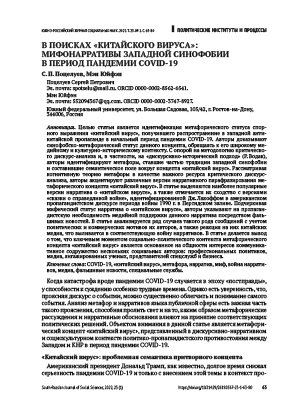Аннотация
Целью статьи является идентификация метафорического статуса спорного выражения «китайский вирус», получившего распространение в западной антикитайской пропаганде в начальный период пандемии COVID‑19. Авторы доказывают синофобско-метафорический статус данного концепта, обращаясь к его широкому медийному и культурно-историческому контексту. С опорой на методологию критического дискурс-анализа и, в частности, на «дискурсивно-исторический подход» (Р. Водак), авторы идентифицируют метафоры, ставшие частью традиции западной синофобии и составившие семантическое поле вокруг концепта «китайский вирус». Рассматривая когнитивную теорию метафоры в качестве важного ресурса критического дискурс-анализа, авторы акцентируют различные версии нарративного парафразирования метафорического концепта «китайский вирус». В статье выделяются наиболее популярные версии нарратива о «китайском вирусе», а также отмечается их сходство с версиями «сказки о справедливой войне», идентифицированной Дж. Лакоффом в американском пропагандистском дискурсе периода войны 1990 г. в Персидском заливе. Подчеркивая мифический статус нарратива о «китайском вирусе», авторы указывают на пропагандистскую необходимость медийной поддержки данного нарратива посредством фальшивых новостей. В статье анализируется ряд случаев такого рода сообщений с учетом политических и коммерческих мотивов их авторов, а также реакция на них китайских медиа, что выливается в соответствующую войну нарративов. В статье делается вывод о том, что ключевым моментом социально-политического контекста метафорического концепта «китайский вирус» является основанное на общности интересов коммуникативное содружество нескольких социальных акторов: профессиональных политиков, медиа, ангажированных ученых, представителей спецслужб и бизнеса.
Ключевые слова
Библиографические ссылки
Alexander, R. J. (2013). Shaping and Misrepresenting Public Perceptions of Ecological Catastrophes: the BP Gulf Oil Spill. Critical Approaches to Discourse Analysis across Disciplines,7, 1–18.
Amatov, A. M., Bondarenko, E. V., Pupynina, E. V. (2019). Amerikanskiy politicheskiy diskurs: metafory voiny i voina metaphor [American Political Discourse: Metaphors of War and War of Metaphors]. Nauchnye vedomosti. Seriia: Gumanitarnye nauki [Scientific Bulletin. Series: Humanities], 38(1), 5–12.
Ankersmit, F. R. (2003). Narrativnaya logika: Semanticheskiy analiz yazyka istorikov [Narrative Logic. A Semantic Analysis of the Historian’s Language]. Moskva: Ideya-Press.
Brugman, B. C., Burgers, C., Vis, B. (2019). Metaphorical Framing in Political Discourse through Words vs. Concepts: A Meta-Aanalysis. Language and Cognition, 11(1), 41–65.
Dijk, Teun A. van (2013). Diskurs i vlast’: reprezentatsii dominirovaniia v iazyke i kommunikatsii [Discourse and Power: Representations of Dominance in Language and Communication]. Moskva: Knizhnyi dom “LIBROKOM”.
Fairclough, N. (1995). Critical Discourse Analysis: Papers in the Critical Study of Language. New York: Longman.
Fuchs, C. (2020). Everyday Life and Everyday Communication in Coronavirus Capitalism. TripleC, 18(1), 375–399.
Gamson, W.A., Modigliani, A. (1989). Media Discourse and Public Opinion on Nuclear Power: A Constructionist Approach. American Journal of Sociology, 95(1), 1–37.
Jacob, J. T. (2020). ‘To Tell China’s Story Well’: China’s International Messaging during the COVID-19 Pandemic. China Report, 56(3), 374–392.
Lakoff, G. (1999). Metaphorical Thought in Foreign Policy. Why Strategic Framing Matters. Berkeley: The University of California at Berkeley and The Rockridge Institute.
Lakoff, G., Johnson, M. (2004). Metafory, kotorymi my zhivem [Metaphors We Live By]. Moskva: Yeditorial URSS.
Lynteris, C. (2018). Plague Masks: The Visual Emergence of Anti-Epidemic Personal Protection Equipment. Medical Anthropology Journal, 37(6), 442–457.
Lynteris, C. (2018). Yellow Peril Epidemics: The Political Ontology of Degeneration and Emergence. In F. Bille, S. Urbansky (Eds) Yellow Perils: China Narratives in the Contemporary World (pр. 34–53). Honolulu: University of Hawaii Press.
Menon, R. (2003). The Sick Man of Asia: Russia’s Endangered Far East. The National Interest, 73, 93–105.
Odijie, M. (2018). The Fear of ‘Yellow Peril’ and the Emergence of European Federalist Movement. The International History Review, 40(2), 358–375.
Panther, K. — U. (2006). Metonymy as a Usage Event. In G. Kristiansen, M. Achard, R. Dirven, F. J. R. de Mendoza Ibáñez (Eds) Cognitive Linguistics: Current Applications and Future Perspectives (pp. 147–186). Berlin: Mouton de Gruyter.
Rasmussen, A. L. (2021). On the Origins of SARS-CoV-2. Nature Medicine, 27(9), 8–9.
Schön, D. A. (1979). Generative Metaphor: A Perspective on Problem-setting in Social Policy. In A. Ortony (Ed.) Metaphor and Thought (pp. 254–283). Cambridge: Cambridge University Press.
Skrynnikova, I. V. (2017). Metaforicheskii freiming politicheskikh sobytii: kak formiruiutsia ubezhdeniia [Metaphorical Framing of Political Events: How Are Beliefs Shaped?]. In Vserossiyskaia konferentsiia po kognitivnoi nauke KISE-2017 [All-Russian Conference on Cognitive Science Kise-2017] (pp. 267–277). Kazan’: Izd-vo KFU.
Sontag, S. (1978). Illness as Metaphor. New York: Farrar, Straus and Giroux,
Wodak, R. (2015). Critical Discourse Analysis, Discourse-Historical Approach. In K. Tracy, C. Ilie and T. Sandel (Eds) The International Encyclopedia of Language and Social Interaction (pp. 1–14). Boston: John Wiley & Sons.
Zhang, D. (2021). Sinophobic Epidemics in America: Historical Discontinuity in Disease Related Yellow Peril Imaginaries of the Past and Present. Journal of Medical Humanities, 42, 63–80.


